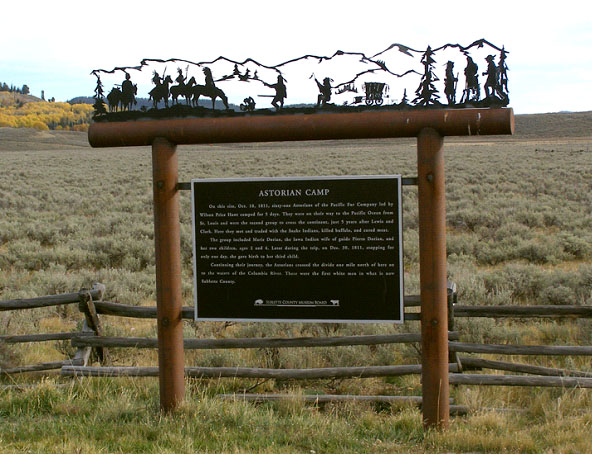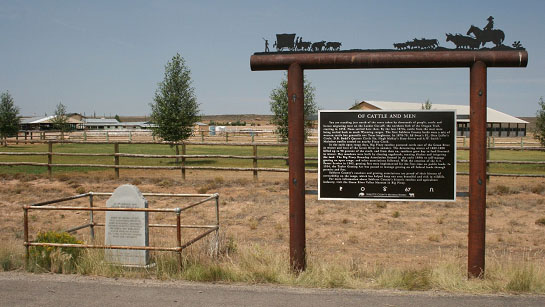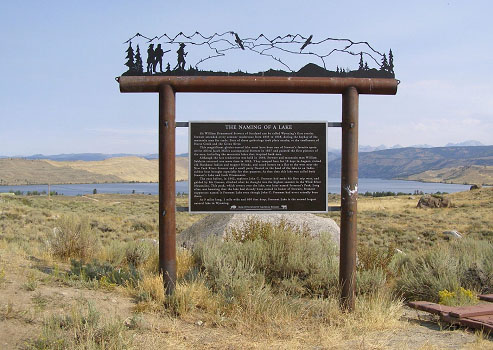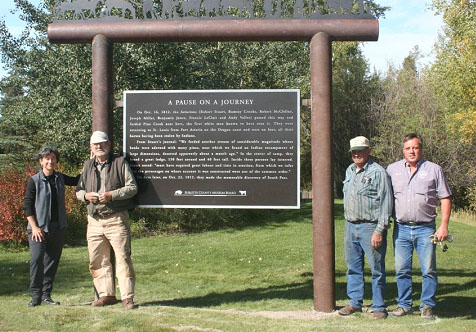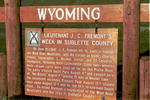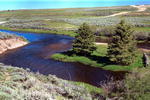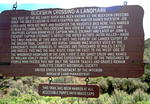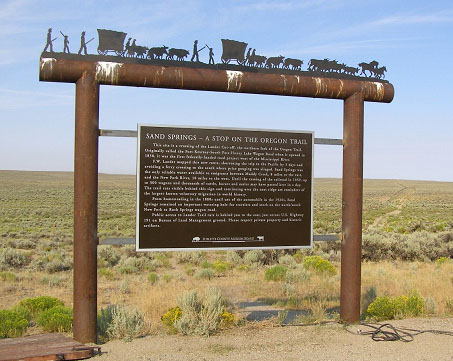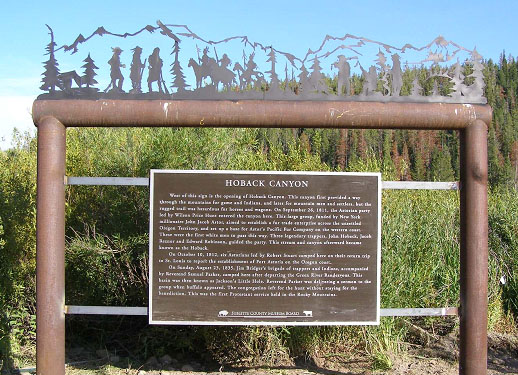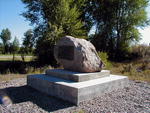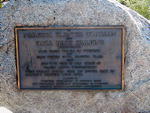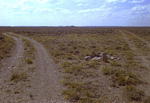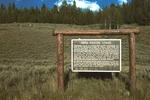|
Sublette County Historical Points of Interest
The Rendezvous had a broad meaning with the early trappers; not only was it a place to which they carried their furs and exchanged them for all sorts of commodities, such as clothing, saddles, bridles, tabacco, whiskey, bright dyes for coloring the trappings of their horses - but it was a place to meet traders who might wish to engage their services for the coming year. It was indeed a place noted for business, pleasure, mirth, gambling and brawls, and the motley collection was not without interest even to the early missionaries. Along about 1835, religious teachers became a regular feature at the Rendezvous. Rev. Samuel Parker made a number of religious talks to white men and Indians at the Green River in 1835. Father De Smet made a number of his winning and pleasant talks in 1840 at this same place. The Green River Rendezvous are commemorated the second Sunday in July each year at the Museum of The Mountain Man in Pinedale. An interpretive sign is located at the Rendezvous grounds in Daniel on property owned by the Sublette County Historical Society. "From the first big beaver season in 1824 to the last Rendezvous in 1840, the Green River Valley was the center of the Rocky Mountain fur trade. Six of the 16 summer Rendezvous (1833, 1835, 1836, 1837, 1839, 1840) were held here at the confluence of Horse Creek and the Green River. For mountain men who trapped during the long cold months for the best fur, the summer Rendezvous provided an opportunity to sell beaver hides, re-supply for the coming year, meet old friends, and celebrate. Rendezvous lasted up to a month and were attended by as many as 3000 trappers, traders, visitors, and Indians coming from hundreds of miles in all directions. The Green River Rendezvous provided a stage for the first Catholic Mass performed in the West by Father DeSmet, the arrival of the first white women to cross the Continental Divide, the sketches of artist Alfred Jacob Miller, the adventures of Scotsman William Drummond Stewart (Wyoming's first tourist), and colorful stories about men like Jim Bridger and Kit Carson. Since 1936, the Green River Rendezvous has been commemorated each year with a celebration the second weekend in July. The Museum of the Mountain Man in Pinedale is dedicated to interpreting and preserving the history of this colorful era.
On US 189/191 near the Hoback Rim, a historical sign marking the spot reads: "On this site, Oct. 18, 1811, sixty-one Astorians of the Pacific Fur Company led by Wilson Price Hunt camped for 5 days. They were on their way to the Pacific Ocean from St. Louis and were the second group to cross the continent, just 5 years after Lewis and Clark. Here they met traded with the Snake Indians, killed buffalo and cured meat. The groups included Marie Dorian, the Iowa Indian wife of guide Pierre Dorian, and her two children, ages 2 and 4. Later during the trip, on Dec. 30, 1811, stopping for only one day, she gave birth to her third child. Continuing their journey, the Astorians crossed the divide one mile north of here on to the waters of the Columbia River. These were the first white men in what is now Sublette County.
This historical marker is located on US 189 between Daniel and Big Piney, near the Sublette County Fairgrounds and Hwy 351 cut-off road "You are standing just north of the route taken by thousands of people, cattle and horses migrating west on the Lander Cut-off, the northern fork of the Oregon Trail, starting in 1858. None settled here then. By the late 1870s, cattle from the west were being trailed back to stock Wyoming ranges. The first Sublette County herds were a mix of western cattle, but generally not Texas longhorns. In 1878-79, Ed Swan's PL, Otto Leifer's Circle D, B. Budd's Quarter Circle Six, Hugh McKay's Sixty-Seven, and A.W. Smith's Muleshoe outfits settled on neary Piney Creek. In the early open range days, Big Piney ranches pastured cattle east of the Green River in winter and west of the Green River in summer. The devastating winter of 1889-1890 killed up to 90 percent of the stock, and from then on ranchers grew hay to feed livestock in winter. Hay meadows were built by clearing sagebrush, running ditches and irrigating the land. The Big Piney Roundup Association formed in the early 1890s to self manage grazing on open range, and other associations followed. With the creation of the U.S. Forest Service in 1905, grazing fees were implemented for the first time on public lands. In 1934, the Taylor Grazing Act was passed to manage grazing on all federal lands through permits and fees. Sublette County's ranchers and grazing associations are proud of their history of stewardship on the range, whihc has helped keep our area beautiful and rich in wildlife. For more information about Sublette County's historic ranches and agriculture industry, visit the Green River Valley Museum in Big Piney.
This marker is located on the Fremont Lake Road at the Fremont Lake overlook approximately three mile outside of Pinedale. Sir William Drummond Stewart of Scotland can be called Wyoming's first tourist. Stewart attended every summer rendezvous from 1833 to 1838, during the heyday of the mountain man fur trade. Four of these gatherings took place nearby, at the confluence of Horse Creek and the Green River. This magnificent glacier-carved lake must have been one of Stewart's favorite spots. Artist Alfred Jacob Miller accompanied Sterwart in 1837 and painted the first pictures of the area, including the mountain lakes that inspired both men. Although the last rendzvous was held in 1840, Stewart and mountain man William Sublette returned one more time in 1842. They camped here for 10 days in August, visited old Shoshone Indian and trapper friends, and raced horses on a flat to the west near the New Fork River. Stewart and a small party floated to the head of the lake in an India-rubber boat brought especially for that purpose. At the time, this lake was called Stewart's Lake and Loch Drummond. The year before, in 1842, explorer John C. Fre3mont had made his first trip west, and guided by Kit Carson, climbed what he thought was the highest summit in the Wind River Mountains. This peak, which towers over the lake, was later named Fremont's Peak. Long after, not knowing that the lake had already been named in honor of Stewart, Fremont supporters named it Fremont Lake even though John C. Fremont had never actually been there. At 9 miles long, 1 mile wide and 600 feet deep, Fremont Lake is the second largest natural lake in Wyoming.
A marker located west of the Pine Creek Bridge in Pinedale, on the North
side of the highway reads:
On
Oct. 16, 1812, the Astorians (Robert Stuart, Ramsay Crooks, Robert McClellan,
Joseph Miller, Benjamin Jones, Francis LeClair and Andy Vallee) passed this way and forded Pine Creek near here, the first white
men known to have seen it. They were returning to St. Louis from Fort Astoria on the Oregon coast and were on foot, all their horses having been stolen by Indians.
From Stuart's Journal: 'We forded another stream of considerable magnitude whose banks were adorned
with many pines, near which we found an Indian encampment of large dimensions, deserted
about a month ago." In the center of camp they found a great lodge, 150 feet around and 40 feet tall. Inside three persons lay interred. Stuart noted: "must have required great labour and time in erection, from which we infer that the personages on whose account it was constructed were not of the common order."
Six days later, on Oct. 22, 1812, they made the memorable discovery
of the South Pass."
The marker sign is maintained by the Sublette County Museum Board.
A marker on the North side of Horse Creek Road 1 mile west of the intersection
with highway 189 reads:
"Sisk-ke-dee
Agie (Green River) Oregon 1832"
"Here
in July 1832 Captain Benjamin Bonneville erected a fort, 2 block houses
and a stockade as protection from the Blackfoot Indians. He was on leave
from the U.S. Army with his trapping and exploring group of 110 men
and wagons. These were the first wagons to cross South Pass. The party
scattered and trapped for several years, doing valuable exploring as
far as California and the Columbia. In the party famed Joe Meeks, Joe
Walker and many Delaware Indians. The fort, a strategic site, was not
used in winter. Bonneville and most of his party returned to Missouri
August 22 1835."
The marker was made in the Wyoming State Pen and erected in October
of 1962. The source for the legend id from the only material known of
Fort Bonneville - "Washington Irving's Captain Bonneville."
7.
RENDEZVOUS BIRTH OF AN EMPIRE
At a location locally known as Trapper's Point, just west of highway
189 between Pinedale and Daniel with turn-off just west of the Cora
Road turn off, on a hill over looking the Green River Valley where most
Rendezvous were held a marker reads:
"The
river below is the Green. The mountains to the west are the Wyomings
(Bear Rivers). Those to the east, the Wind Rivers. Along the river banks
below are the Rendezvous sites of 1833, 1835 (North Fork), 1836, 1837
(Cottonwood), 1839, 1840 and Fort Bonneville. Trappers, traders and
Indians from throughout the west here met the trade wagons from the
east to barter, trade furs, gamble, drink, frolic, pray and scheme.
The Indians, Delaware and Iroquois, brought by the Hudson Bay Company,
Snakes, Bannocks, Gros Ventre, Flatheads, Nez Pierce, Crows and Chinooks
here made their first contact with the white man. The warring Blackfeet
did not participate. The Rocky Mountain Fur Company, Hudson Bay Company,
Captain Bonneville, Wyeth and free trappers, controlled the trade. The
people of God, Marcus and Narcissa Whitman, Mr. and Mrs. Spalding, Samuel
Parker, Father De Smet, Jason Lee and W. H. Gray tempered the hilarity.
Jim Bridger, Milton and Bill Sublette, Tom Fitzpatrick, Joe Walker,
Joe Meeks, Kit Carson, Batiste Gervais, Bob Jackson, Moses (Black) Harris,
Lucien Fontenelle, Etiene Provat, Henry Freab, Andy Dripps, Robert Campbelle,
Henry Vandenburg, Sir W. D. Stewart and the artist A. J Miller all were
part of this and left their names embedded in the annals of the west.
Scattering for the value of a beaver plew and to see what was beyond
the horizon, their trails became the highways of an empire at the cost
of many a violent death."
Ten acres of B.L.M land were acquired by the Sublette County Historical
Board for the erection of the marker, which was completed in June of
1964 and financed by the Board. Floyd Schneider did the rock work, Charles
Coppock the lettering and Jim Harrower the text.
A marker near silver creek east of Boulder reads:
"On
June 10, 1842, J.C. Fremont left St. Louis to explore the Wind River
Mountains, with Kit Carson as guide, Charles Preuss, topographer, L.
Maxwell, hunter and 20 Canadian Voyageurs, including Basil LaJeunesse.
Eight two-wheeled, mule drawn carts were used as far as the Platte River.
The party crossed South Pass August 8 and camped here at "Two Buttes"
August 9. Leaving 10 men at Boulder Lake, the lieutenant ascended Fremont
Peak August 15, stayed her again August 17, and on the 19th re-crossed
South Pass. So ended Fremont's exploration of the Wind River Mountains
and his stay in Sublette County."
The marker was made at the Wyoming State Penitentiary and erected in
December 1963. Jim Harrower found the source for the material in the
legend in the diary of Fremont's cartographer Charles Preuss. He was
a German, and the diary was found after World War II.
9.
SEEDS-KEE-DEE-AGIE, SPANISH RIVER, RIO VERDE, GREEN RIVER
A large marker located on the east side of highway 189, between Labarge
and Kemmerer, across from Holden Hill reads:
"To
the Shoshone Indian, this river was the Seeds-Kee-Dee Agie (Prairie
Chicken River). On Sept. 16 1811, the Astorians near it's headwaters
termed it the Spanish River. To the Spaniards, far to the south, it
was the Rio Verde (Green River). Jedediah Smith and his Mountain Men,
making the first westward crossing of the south Pass by white men, camped
near here Mar 19, 1824 on the Seeds-Kee-Dee. They trapped the river
and its forks which were named for them: LaBarge, Ham's, Black's, Smith's,
Henry's, etc. These waters were considered as the greatest beaver waters
ever known. The upper reaches became the center of the fur trade and
the Rendezvous. In 1841 the fur trade ceased, but the trappers had blazed
the trails for the emigrants. For forty-nine years over the Oregon and
California trails, thousands of emigrants going west, crossed these
waters nearby. The many that drowned and died were buried along the
river banks. The Mountain Men guided, manned the ferries and traded
with the emigrants. Graves, marked and unmarked, names cut in the rocks
and wagon trails worn deep remain with the legend and lore of a great
river of the West - The Green."
The marker was made and erected with the help of Lincoln County Bureau
of Land Management and the Sublette County Historical Society, and was
completed in the fall of 1964. The name and script are by Jim Harrower.
A marker at Buckskin Crossing of Big Sandy Creek on the east side of
the road reads:
"This
part of the Big Sandy River has been known as the Buckskin Crossing
since 1860's. Legend is that a trapper and hunter named Buckskin Joe
lived here with his wife and daughter. The daughter died here. This
marker is near the cabin site. This crossing was used by the fur companies
and trappers, Captain Bonneville, Captian W.D. Stewart and later by
John C. Fremont. Captain Stewart's artist - the noted Alfred Jacob Miller
- made the first painting of the area in 1837. This ford of the Lander
Cut-off of the Oregon Trail, campsite and burial ground was heavily
used by the emigrants, their hundreds of wagons and thousands of mules,
cattle and horses. This was the mail route from the east to the west
side of the Wind River Mountains in the early 1900's. Big Sandy Creek
was named by William Ashley on his trapping expedition in 1825. Of the
thousands of people who passed this way only the wagon tracks and graves
remain. This trail has been marked at all accessible points with brass
caps."
The marker was erected in June of 1965 with the assistance of the U.
S. Dept. of the Interior, and Bureau of Land Management.
11.
JAMES BRIDGER - TRAPPER 1844
Names Hill, located on the west side of Highway 189 about 5 miles south
of LaBarge, is a very important location, being on the west side of
the Green River where thousands of people made a crossing and camped
before going on to Immigrant Springs and on down into Utah. Hundreds
of names had been carved in the rocks: many of them now have crumbled
away. The most famous is James Bridger. To protect it a fences has been
placed around it and a marker placed next to it which reads:
"He
little knew that when he cut his name, or had it cut, in this stone,
that it would be engraved in the annals of the West deeper than that
of any other man. As one of the world's outstanding explorers he guided
emigrants, railroads and army in the expansion of the nation"
The sign was made by the Sublette County Historical Society; and with
the help of the Lincoln County Board of Commissioners and the Highway
Department, put the fence around the area. The First National Bank of
Kemmerer put a marker right by the road that lead over the bank between
the cliffs. This road can still be followed and is well marked, but
there are washes in places making it hard to travel except by 4 wheel
drive vehicles.
12.
SAND SPRINGS - A STOP ON THE OREGON TRAIL
Located on US 191 just north of Sand Draw and the Hwy 351 cutoff road is a historical marker for the Lander Trail.
"This site is a crossing of the Lander Cut-off, the northern fork of the Oregon Trail. Originally called the Fort Kearney-South Pass-Honey Lake Wagon Road when it opened in 1858, it was the first federally-funded road project west of the Mississippi River. F.W. Lander mapped this new route, shortening the trip to the Pacific by 5 days and avoiding a ferry crossing to the south where price gouging was alleged. Sand Springs was the only reliable water available to emigrants between Muddy Creek, 8 miles to the east, and the New Fork River, 10 miles to the west. Until the coming of the railroad in 1869, up to 300 wagons and thousands of cattle, horses and mules may have passed here in a day. The trail ruts visible behind this sign and continuing over the next ridge are reminders of the largest known voluntary migration in world history. From homesteading in the 1880s until use of the automobile in the 1920s, Sand Springs remained an important watering hole for travelers and stock on the north/south New Fork to Rock Springs wagon road. Public access to Lander Trail ruts is behind you to the east, just across U.S. Highway 191 on Bureau of Land Management ground. Please respect private property and historic artifacts.
13.
OREGON TRAIL - LANDER CUT-OFF (SOUTH PASS AREA)
A marker at South Pass reads:
"This
is an old Indian trail used by the Indians and the trappers of the fur
period. A short-cut to the Snake River country, it was proposed as an
emigrant road by the Mountain Man John Hockaday in 1854. No emigrant
trails crossed the mountains north of here. It was improved as a wagon
road for the Government by F.W. Lander in 1859 to avoid dry wastes of
the road to the south and provide more water, wood and forage. Here
it commenced, the crossing of the south end of the Wind River Mountains
and the Continental Divide and on to the Pacific northwest. Thirteen
thousand people and thousands of domestic animals passed this way in
1859 and thirty years thereafter was used as heavily, setting the destiny
of an empire. These wagon tracks and lonely graves, a great landmark
of history have been recognized for preservation by: U.S. Department
of the Interior - Bureau of Land Management and Sublette County Historical
Society. This trail has been marked at all accessible points with brass
caps."
This marker is located on US 189/191 just south of the Hoback Rim, north of Bondurant.
West of this sign is the opening of Hoback Canyon. This canyon first provided a way through the mountains for game and Indians, and later for mountain men and settlers, but the rugged trail was hazardous for horses and wagons. On September 26, 1811, the Astorian party led by Wilson Price Hunt entered the canyon here. This large group, funded by the New York millionaire John Jacob Astor, aimed to establish a fur trade enterprise across the unsettled Oregon Territory, and set up a base for Astor's Pacific Fur Company on the western coast. These were the first white men to pass this way. Three legendary trappers, Hoback, Reznor and Robinson, guided the party. This stream and canyon afterward became known as the Hoback.
On October 10, 1812, six Astorians led by Robert Stuart camped here on their return trip to St. Louis to report the establishment of Fort Astoria on the Oregon coast.
On Sunday, August 23, 1835, Jim Bridger's brigade of fur trappers and Indians, accompanied by Reverand Samuel Parker, camped here after departing the Green River Rendezvous. This basin was then known as Jackson's Little Hole. Reverend Parker was delivering a sermon to the group when buffalo appeared. The congregation left for the hunt without staying for the benediction. This was the first Protestant serivce held in the Rocky Mountains.
A marker about two miles south of Daniel on Highway 189 reads:
"Rev.
Pierre De Smet (1801-1873) was born in Belgium but came to America in
1821, joined the Jesuit Society and begun his work with the Indians.
In his work he established 16 treaties, crossed the ocean 19 times and
travelled 180,000 miles on his errends of charity for the Indians who
knew him as 'The Sincerest Friend.'
"On
July 5, 1840, in the presence of 2000 Indians, trappers, and traders
he offered the first Holly Mass in what is now Wyoming on an alter of
native stone decorated with wild flowers. In Father De Smet's own words,
'It was a spectacle truly moving to the heart of a missionary that this
immense family, composed of so many tribes should prostrate themselves
in equal humility before the Divine Host.'
"The
monument at the site was erected in 1925 and a commemorative mass is
offered there annually in July. On July 4, 1940, the 100th anniversary
of the first mass, a Pontifical High Mass was offered by the Most Rev.
Bishop McGovern assisted by more than 30 priest and attended by about
2000 people."
A little chapel was erected by the Catholic Church on the knoll above
the Green River where the first Catholic Mass was held by Father De
Smet, just east of the Road Marker on highway 189 south of Daniel. Each
year on the first Sunday in July services are held there.
A marker on the east side of highway 189 just north of Daniel reads:
"To
Narcissa Whitman and Eliza Hart Spalding Missionaries. First white women
in Wyoming and first women over the Oregon Trail 1836. July 6 to July
16 was spent at Green River Rendezvous. These Pilgrim Women took an
active part in religious services held here. Placed by Wyoming Federation
of Women's Clubs, The Historical Landmark Commission of Wyoming, Sublette
County Historical Society."
The marker was erected to commemorate the 100th year after the two white
women had made their 10 day stay in the area. Five acres were bought
by the Sublette County Historical Society when it was first organized
in 1936 that are in the middle of the area where 6 of the early Rendezvous
were held. The Society was organized and the first of the recent Rendezvous
enacted on these acres, in honor of Eliza Spalding and Narcissa Whitman.
This marker is on the main highway between Farson and Lander, in the
very southeastern corner of Sublette County. Most of the people heading
west camped at Pacific Springs North of the Oregon Buttes. After traveling
in groups for several more miles west some decided they would rather
goo to the gold fields in California, or to the area the Mormons were
settling in Utah, and it was at this spot that the groups parted, many
still determined to go on to Oregon. These old trails can still be seen
and have been marked. As stated on the sign the first known persons
to pass over South Pass were Robert Stewart and friend as they made
their way east to take messages to John Astor of the Pacific Fur Company,
in the fall of 1812. Twelve years later the Ashley-Henry men made their
way back to the beaver trapping areas led by Jedediah Smith and Tom
Fitzpatrick. By 1836 many groups were using that way west, and in that
year the missionaries and wives were headed for Oregon. Eliza Spalding
and Narcissa Whitman were the first known white women to go over the
route. The peak year for travel was 1852 when it is estimated that over
40,000 persons passed this way.
19.
GRAVE OF CHARLOTTE DANSIE - 1862
A tombstone on the road from Farson to Lander reads:
"But
should we die before our journey is through, all is well, all is well."
In loving memory of Charlotte R., daughter of Wm. and Susan Rutland
born in Suffolk England. Died in child birth with infant son Joeseph
at Pacific Springs Wyo. Sept. 21, 1862, while crossing the plains to
Utah. In Ansel P Harmon Co. leaving husband and five children. Caroline
Moyers buried in the same grave. Died Sept. 21 1862 of Bilious fever
age 25 years. Grave located July 3, 1939 by Joseph H. and Leroy Dansie.
Erected in 1939.
Emigrant Springs was a well known area for the parties to pass through
to Utah and California. It is an isolated spot and hard to locate for
those who do not know the correct road to it, but it was a lush meadow
with a large spring of cold water, where the women could wash, people
bathe, horses get rested up, etc. It is hard to say how many people
may have been buried there. The two known graves are being washed out.
A rock slab was put up by Cap Nickerson of Lander in 1915. It said Oregon
Trail 1843. This stone has been removed by some thoughtless person.
The spring is enclosed by rocky bluffs on which hundreds of names are
carved, many of which are hardly legible now. Emigrant Springs is on
the west side of the highway between Fontenelle and Slate Creeks.
An Oregon Trial marker is seldom seen as it is on the Trail between
the Sweetwater crossing and Pacific Springs. It is not known how many
years ago it was put up or by whom. In several places the Oregon Trail
and Lander Cut-off have markers that have been chiseled in rocks by
people passing. In later years the old trail was marked by cement posts
with bronze plaques embedded in the top of each one. The marking took
several summers and was carried out by the Sublette County Historical
Society, the U.S. Dept. of the Interior and Bureau of Land Management.
Many of the bronze markers have been pried off the posts by thoughtless
people, so seldom does anyone get to see one with the plaque still on.
22.
BIRTH OF A BABY ON JULY 3RD 1864
This was a rare find. Many grave markers have been found along the Oregon
Trail but this is the only known one marking a birth. Exactly one hundred
years after the date on the marker a group of interested people gathered
to picnic and to set the stone in concrete as a permanent marker. It
was found near this spot, on the Dan Budd ranch, not far from Big Piney
by a young woman. The stone had "Monlen Hefflem born here July
3rd 64" on it with the date again chiseled out on the back.
On a bench east of Green River, on the way to Green River Lakes approximately
30 miles north of Cora, Wyoming a marker reads:
"The
Gros Ventre Lodge, believed to be the first full time dude ranch in
Wyoming was built on the hill beyond in 1897 by William (Billy) Wells
and operated until 1908. It was named for the Gros Ventre (now Tosi
Creek) and was locally called the 'Dog Camp' because a pack of hounds
was kept for hunting. Improvements included a central lodge, guest cabins,
and service buildings. Big game hunting was the chief attraction and
drew prominent American and European sportsmen for extended vacations.
A.B. Wallihan, early noted wildlife photographer made many of his outstanding
pictures while staying here. A Postoffice, Wells, Wyoming was established
in 1899 and continued during the years the ranch operated.
24.
THE OLDEST DATE IN SUBLETTE COUNTY
The oldest carving date found in Sublette County is located on the Ferris
Ranch near Dell Creek, in the Hoback Basin. Don Ferris found this on
a rock covered with shrubs, near his home, where he had lived since
about 1919. He found it in 1961. the carving is M A. 1791. It could
be an M P. The A or P is indistinct. In Nov. 1966 Jim Harrower and Bill
Isaacs checked it out and made a photo. There was about eighteen inches
of snow on the ground. The lettering is very old as hard lichens have
grown in the indentations.
|
